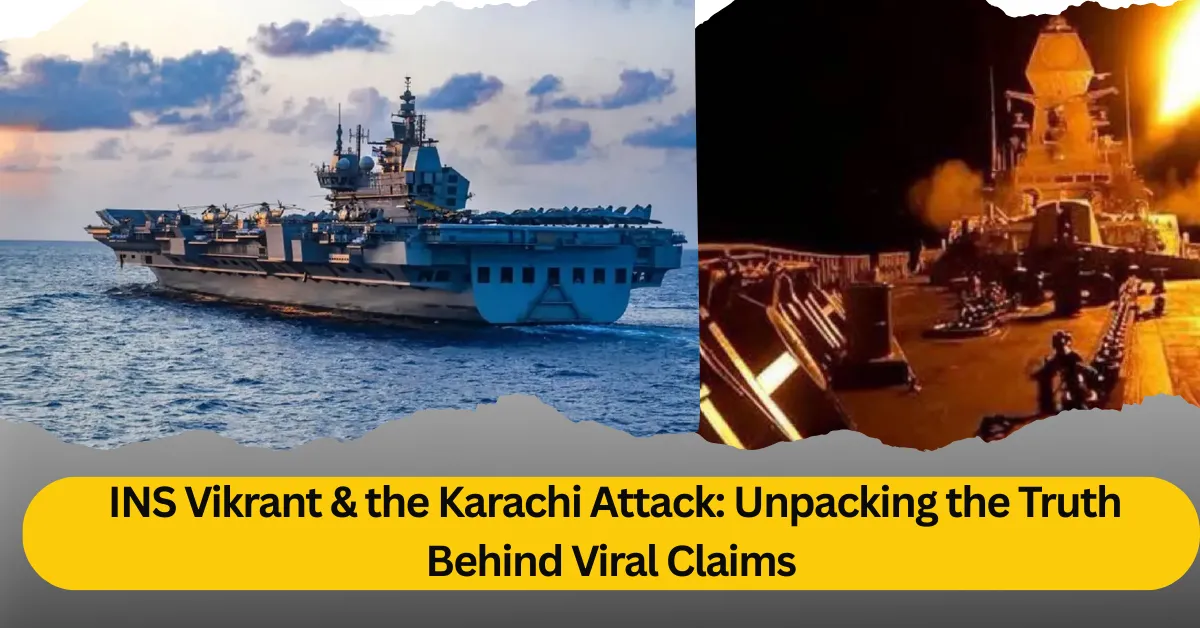Recent reports of explosions in Karachi have raised concerns and prompted a closer examination of India’s naval activity in the Arabian Sea. This situation draws parallels with historical events, specifically the Indian Navy’s operations during the 1971 Indo-Pakistani War, and necessitates a clear understanding of the current context.
Current Situation: Naval Mobilization and Reported Explosions
According to recent reports, explosions have been heard in Karachi, a major port city in southern Pakistan. These events coincide with the mobilization of the Indian Navy’s Western Naval Command, which has deployed the aircraft carrier INS Vikrant and several destroyers in the Arabian Sea. Among the destroyers is INS Visakhapatnam, a key asset in India’s naval fleet.
The mobilization of the Indian Navy comes in response to what India describes as “unprovoked attacks” from Pakistan. The Indian armed forces – Army, Air Force, and Navy – have been placed on high alert and are actively responding to the situation.
India has reported intercepting and neutralizing multiple missile threats, including at least 8 in Jammu and Kashmir and 30 in Rajasthan’s Jaisalmer. Additionally, Pakistani drones have been shot down in several border states. India has also claimed to have shot down a Pakistani F-16 fighter jet and two JF-17 fighter jets.
India has also conducted counter-offensive measures, including a drone attack on Lahore, which it claims disabled Pakistan’s defense systems. Reports indicate that areas beyond Lahore, including Karachi and Gujranwala, have also been affected.
To address the heightened security situation, the Bureau of Civil Aviation Security (BCAS) has directed all airlines and airports across India to enhance security measures. These measures include mandatory Secondary Ladder Point Checks (SLPC) for all passengers and a ban on visitor entry into terminal buildings. The Ministry of Civil Aviation has also announced the deployment of Air Marshals.
Foreign Secretary Vikram Misri has reiterated India’s stance, emphasizing that its retaliatory actions are “measured, precise, and non-escalatory.” The current escalation of tensions is rooted in the April 22 terror attack in Pahalgam, India, where the Pakistan-sponsored ‘The Resistance Front’ was responsible for the deaths of 26 people.
Following the Pahalgam attack, India launched Operation Sindoor, targeting terror installations within Pakistan and Pakistan-occupied Kashmir (PoJK). This operation has led to a series of retaliatory actions, including the recent attacks and naval deployments.
Historical Context: The 1971 Indo-Pakistani War and Naval Operations
To understand the significance of the current naval mobilization and the references to INS Vikrant, it is crucial to revisit the 1971 Indo-Pakistani War. This conflict was pivotal in the creation of Bangladesh and saw significant naval engagements.
During the 1971 war, the Indian Navy played a decisive role. Operation Trident, launched on the night of December 4-5, 1971, targeted Karachi Port with devastating effect. Indian missile boats sank Pakistani naval vessels and set ablaze oil storage facilities, severely crippling Pakistan’s naval capabilities and disrupting its war efforts.
INS Vikrant, an aircraft carrier, was a major asset for the Indian Navy during the 1971 war. While Operation Trident was carried out by missile boats, INS Vikrant was deployed in the eastern theater, where its air power proved crucial in neutralizing Pakistani naval forces and establishing a blockade.
INS Vikrant: A Symbol of Naval Power
INS Vikrant’s role in the 1971 war established it as a symbol of Indian naval power. The current deployment of the new INS Vikrant, commissioned in 2022, carries this historical weight and serves as a reminder of India’s naval capabilities.
The current situation in the Arabian Sea, with the deployment of INS Vikrant and other destroyers, echoes the strategic importance of naval power demonstrated in 1971. While the context and nature of the conflict may differ, the underlying principle of naval readiness and strategic positioning remains consistent.
Analyzing the Situation
The recent explosions in Karachi, coupled with India’s naval mobilization, indicate a serious escalation of tensions. The historical context of the 1971 war, particularly Operation Trident, serves as a stark reminder of the potential consequences of such conflicts.
India’s emphasis on “measured, precise, and non-escalatory” responses suggests a strategy aimed at deterrence and targeted action. However, the situation remains fluid, and the potential for further escalation is a significant concern.
The international community is likely watching these developments closely, with concerns about regional stability and the potential for a wider conflict. Diplomatic efforts to de-escalate the situation and promote dialogue will be crucial in the coming days.
FAQs on the Karachi Situation and India-Pakistan Tensions
What caused the explosions in Karachi?
Reports indicate explosions in Karachi, coinciding with Indian naval deployments in the Arabian Sea, amidst rising tensions.
What is India’s naval response?
India’s Western Naval Command has mobilized INS Vikrant and destroyers, including INS Visakhapatnam, in the Arabian Sea.
Why is India mobilizing its naval forces?
In response to “unprovoked attacks” from Pakistan, according to Indian sources.
What other military actions have been reported?
India reports intercepting missiles, shooting down drones, and conducting a counter-offensive drone attack on Lahore.
What is Operation Sindoor?
India launched attacks targeted at terror installations in Pakistan and PoK under Operation Sindoor.
What is the role of INS Vikrant in the current situation?
INS Vikrant, a symbol of Indian naval power, is part of the Western Naval Command’s mobilization in the Arabian Sea.
What security measures are being taken in India?
Enhanced security measures at airports, including mandatory checks and restrictions on terminal access.
What is the historical significance of Karachi Port in the context of India-Pakistan conflict?
Karachi Port was a key target during the 1971 war, particularly in Operation Trident.
What is India’s stated position on its actions?
India maintains its actions are “measured, precise, and non-escalatory.”
What is the international concern regarding the situation?
Concerns about regional stability and the potential for wider conflict.

